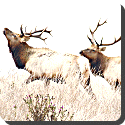 Elk — The elk, or wapiti (Cervus canadensis), is the second largest species of deer in the world and one of the largest mammals in North America and eastern Asia. In the deer family (Cervidae), only the moose, Alces alces (called an “elk” in Europe), is larger. Wapiti are almost identical to red deer found in Europe, of which they were long believed to be a subspecies; they have recently been determined to be a distinct species based on DNA evidence.
Elk — The elk, or wapiti (Cervus canadensis), is the second largest species of deer in the world and one of the largest mammals in North America and eastern Asia. In the deer family (Cervidae), only the moose, Alces alces (called an “elk” in Europe), is larger. Wapiti are almost identical to red deer found in Europe, of which they were long believed to be a subspecies; they have recently been determined to be a distinct species based on DNA evidence.
Elk range in forest and forest-edge habitat, feeding on grasses, plants, leaves and bark. Although native to North America and eastern Asia, they have adapted well to countries where they have been introduced, including New Zealand and Argentina. Their high level of adaptability poses a threat to endemic species and ecosystems where they have been introduced.
Male elk have large antlers which are shed each year. Males engage in ritualized mating behaviors during the rut, including posturing, antler wrestling and bugling, a loud series of screams which establishes dominance over other males and attracts females. The bugle call is one of the most distinctive calls in nature.
Elk are susceptible to a number of infectious diseases, some of which can be transmitted to livestock. Efforts to eliminate infectious diseases from elk populations, largely through vaccination, have had mixed success.
Some cultures revere the elk as a spiritual force. In parts of Asia, antlers and their velvet are used in traditional medicines. Elk are hunted as a game species; the meat is leaner and higher in protein than beef or chicken.
The elk is a large animal of the artiodactyle ungulate order, possessing an even number of toes on each foot, similar to those of camels, goats and cattle. It is a ruminant species, with a four-chambered stomach, and feeds on grasses, plants, leaves and bark. During the summer, elk eat almost constantly, consuming between 4 and 7 kg (10 to 15 lb) daily. In North America, males are called bulls, and females are called cows. In Asia, stag and hind, respectively, are sometimes used instead.
Elk are more than twice as heavy as mule deer and have a more reddish hue to their hair coloring, as well as large, buff colored rump patches and smaller tails. Moose are larger and darker than elk, bulls have distinctively different antlers and moose do not herd. Elk cows average 225 kg (500 lb), stand 1.3 m (4½ ft) at the shoulder, and are 2 m (6½ ft) from nose to tail. Bulls are some 25% larger than cows at maturity, weighing an average of 320 kg (700 lb), standing 1.5 m (5 ft) at the shoulder and averaging 2.5 m (8 ft) in length. The largest of the subspecies is the Roosevelt elk, found west of the Cascade Range in the U.S. states of California, Oregon and Washington, and in the Canadian province of British Columbia. Roosevelt elk have been reintroduced into Alaska, where males have been recorded as weighing up to 600 kg (1,300 lb).
Only the males have antlers, which start growing in the spring and are shed each winter. The largest antlers may be 1.2 m (4 ft) long and weigh 18 kg (40 lb). Antlers are made of bone which can grow at a rate of 2.5 cm (1 inch) per day. While actively growing, the antlers are covered with and protected by a soft layer of highly vascularised skin known as velvet. The velvet is shed in the summer when the antlers have fully developed. Bull elk may have six or more tines on each antler; however, the number of tines has little to do with the age or maturity of a particular animal. The Siberian and North American elk carry the largest antlers while the Altai wapiti have the smallest. The formation and retention of antlers is testosterone-driven.[18] After the breeding season in late fall, the level of pheromones released during estrus declines in the environment and the testosterone levels of males drop as a consequence. This drop in testosterone leads to the shedding of antlers, usually in the early winter.
Adult elk usually stay in single-sex groups for most of the year. During the mating period known as the rut, mature bulls compete for the attentions of the cows and will try to defend females in their harem. Rival bulls challenge opponents by bellowing and by paralleling each other, walking back and forth. This allows potential combatants to assess the others antlers, body size and fighting prowess. If neither bull backs down, they engage in antler wrestling, and bulls sometimes sustain serious injuries. Bulls also dig holes in the ground, in which they urinate and roll their body. The urine soaks into their hair and gives them a distinct smell which attracts cows.
 Kids Portal For Parents India Kids Network
Kids Portal For Parents India Kids Network






